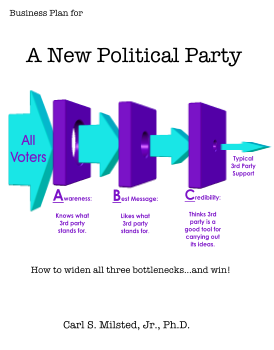It’s Coke or Pepsi Time
After the Strategic Planning Team did its thing, the LP hired a marketing professional to figure out how to market the LP. $50,000 later, he concluded: target small businesses.
This was a very informed decision, stemming from several factors:
-
The LP had limited resources, so it couldn’t target everyone.
-
The LP should target people with a high likelihood of joining. Many members were already small business owners.
-
The LP should attract a group which would help attract other groups. This spoke against targeting groups such as drug users.
All this was intelligent, based on measurements, and very useful for targeting initial adopters. I will use similar reasoning in Part 5 on starting from scratch.
However, in the grander scheme of things, this prescription overlooks the Libertarian Party’s most important marketing mistake: you cannot win elections in the United States by targeting only a narrow demographic. The party’s radical stances rule out significant victories even if there were sufficient resources to target all sympathetic groups.
Here is an important example of the difference between politics and marketing a typical consumer product: there is no prize for third place, and little for second.
Politics is not like selling a fine wine or liquor, where you can target a particular market segment and be successful. Politics is like selling mass-market soft drinks, where you have to be popular enough to support a local bottler or you get priced out of the market. Politics is about Coke vs. Pepsi; not Absolut vs. Stolichnaya.
A political party must market to men and women, old and young, black and white, rich and poor…or it will lose.
Yes, a party can write off a few significant demographic groups -- the Republicans scrape by with very few black votes – but such failures must be made up for by high success elsewhere.
A party that successfully recruits every small business owner in the country still has way too few votes to win anywhere. Throw in hardcore science fiction readers, marijuana activists and gun people and you still don’t have enough to win. (Yes, if you get all marijuana users and gun owners, you might have a big enough demographic base, but these are heterogeneous markets.)
Too much demographic focus is a prescription for disaster! (And this criticism applies also to the attempted “demographic filtering” used during Project Archimedes.) It is far better to do a mediocre job of reaching a broad demographic than it is to do an excellent job of reaching a narrow demographic.
This presents a problem. If resources are limited, and we cannot focus our marketing materials, what is a small startup party to do?
One form of targeting is possible: geographic targeting. A political party need not be strong everywhere in order to win elections. It merely needs to be strong in one or more political districts.
Many libertarians are realizing this, but the favorite solution is rather inefficient: The Free State Project. Moving is expensive. Unless you are coming right out of college, an interstate move can easily cost $5000—and that’s without hiring professional movers. Then, there is the cost to one’s career, distance from family and old friends…and New Hampshire is cold. But let’s keep the $5000 figure and multiply by the desired 20,000 members. That’s $100 million dollars! And that’s just setup fees! The cost of doing actual politics comes afterwards.
I think there are cheaper ways to geographic targeting. I will describe some of them in Part 5.
But before leaving the subject, I will concede that the Free State Project approach is probably the only viable approach for an ultra-radical libertarian party that wants to win elections. It is the best bet for those who resist the lessons of Parts 2 and 3.
But back to the marketing study: there was wisdom there. Some demographic focus can be used to get early adopters, but it should be rapidly followed up with marketing materials for those early adopters to reach a broader demographic in their home areas, in order to actually win elections. The marketing expert cannot be blamed for overlooking this fact; in fact, he probably didn’t. Making the more important recommendation was outside of his mandate. This is a decision that a national convention has to make.
Previous
| 1
| 2
| 3
| 4
| 5
| 6 | 7
| 8
| 9
| 10
| 11
| 12
| 13
| 14
| 15
| 16
| Next
Copyright 2007, Carl S. Milsted, Jr. All rights reserved.
|






